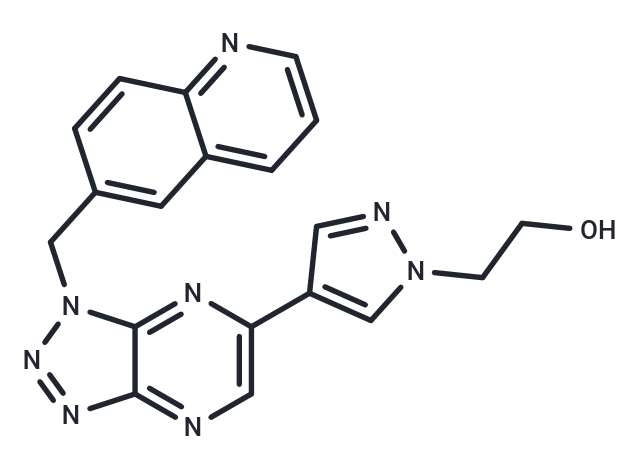Shopping Cart
- Remove All
 Your shopping cart is currently empty
Your shopping cart is currently empty

MET Tyrosine Kinase Inhibitor PF-04217903 is an orally bioavailabe, small-molecule tyrosine kinase inhibitor with potential antineoplastic activity.

| Pack Size | Price | Availability | Quantity |
|---|---|---|---|
| 1 mg | $32 | In Stock | |
| 2 mg | $45 | In Stock | |
| 5 mg | $67 | In Stock | |
| 10 mg | $98 | In Stock | |
| 25 mg | $180 | In Stock | |
| 50 mg | $303 | In Stock | |
| 100 mg | $548 | In Stock | |
| 1 mL x 10 mM (in DMSO) | $72 | In Stock |
| Description | MET Tyrosine Kinase Inhibitor PF-04217903 is an orally bioavailabe, small-molecule tyrosine kinase inhibitor with potential antineoplastic activity. |
| Targets&IC50 | c-Met:4.8 nM |
| In vitro | Although PF-04217903 and sunitinib combination therapy does not inhibit tumor growth in sunitinib-sensitive B16F1 and Tib6 tumor models, it significantly inhibits tumor growth and angiogenesis in sunitinib-resistant EL4 and LLC tumor models compared to the administration of either sunitinib or PF-04217903 alone. This indicates the functional role of the HGF/c-Met axis in sunitinib-resistant tumors. |
| In vivo | PF-04217903 markedly inhibits the clonal growth of LXFA 526L and LXFA 1647L, with IC50 values of 16 nM and 13 nM, respectively, and its efficacy is enhanced when used in combination with cetuximab. It effectively inhibits c-Met-driven biological processes, including the growth, movement, invasion, and morphological changes of various tumor cells. At a concentration of 2 μM, PF-04217903 promotes cell death in GTL-16 cells, involving the downregulation of phosphorylated 4E-BP1, ERK/MAPK-related proteins, and the PI3K/AKT pathway. PF-04217903 exhibits higher selectivity compared to crizotinib or PF-02341066, with over 1000 times greater selectivity for c-Met than for a panel of 208 other kinases, and it is more sensitive to c-Met oncogenic mutations. Besides WT c-Met, PF-04217903 similarly inhibits the activity of c-Met-H1094R, c-Met-R988C, and c-Met-T1010I mutants with IC50 values of 3.1 nM, 6.4 nM, and 6.7 nM, respectively, but it does not inhibit c-Met-Y1230C with an IC50 of >10 μM. Combined with sunitinib, PF-04217903 significantly inhibits endothelial cell proliferation without affecting tumor cells such as B16F1, Tib6, EL4, and LLC. |
| Kinase Assay | Cellular c-Met phosphorylation ELISA: A549 cells with endogenous human WT c-Met are seeded in 96-well plates in growth medium and cultured overnight. On the second day of the assay, the growth medium is replaced with serum-free medium (with 0.04% BSA). Serial dilutions of PF-04217903 are added to each well, and cells are incubated at 37 °C for 1 hour. Then 40 ng/mL HGF is added to the cells for 20 minutes. The cells are washed once with HBSS supplemented with 1 mM Na3VO4, and protein lysates are generated from cells using lysis buffer. Phosphorylation of c-Met is assessed by an ELISA method utilizing capture antibodies specific for c-Met and a detection antibody specific for phosphorylated tyrosine residues. Antibody-coated plates are incubated in the presence of protein lysates at 4 °C overnight and washed with 1% Tween 20 in PBS seven times. HRP-PY20 (horseradish peroxidase-conjugated anti-phosphotyrosine) is diluted 1:500 in blocking buffer and added to each plate for 30 minutes. Plates are then washed again, and TMB peroxidase substrate is added to initiate the HRP-dependent colorimetric reaction and the reaction stopped by addition of 0.09 N H2SO4. ELISA end points are the absorbance measured at 450 nm using a spectrophotometer. IC50 value is calculated by concentration-response curve fitting utilizing a Microsoft Excel-based four-parameter analytical met |
| Cell Research | Cells are treated with different concentrations PF-04217903 for 4 days. Cell proliferation is assessed by counting content of each well using a Coulter counter machine.(Only for Reference) |
| Molecular Weight | 372.38 |
| Formula | C19H16N8O |
| Cas No. | 956905-27-4 |
| Smiles | OCCn1cc(cn1)-c1cnc2nnn(Cc3ccc4ncccc4c3)c2n1 |
| Relative Density. | 1.53 g/cm3 |
| Storage | Powder: -20°C for 3 years | In solvent: -80°C for 1 year | Shipping with blue ice. | ||||||||||||||||||||||||||||||
| Solubility Information | DMSO: 20 mg/mL (53.71 mM), Sonication is recommended. Ethanol: < 1 mg/mL (insoluble or slightly soluble) | ||||||||||||||||||||||||||||||
Solution Preparation Table | |||||||||||||||||||||||||||||||
DMSO
| |||||||||||||||||||||||||||||||

Copyright © 2015-2025 TargetMol Chemicals Inc. All Rights Reserved.